Last Updated on
It’s been a long time coming: artificial intelligence traces its roots back sixty years, even longer in novels. It’s been a slow business with at least a couple of AI Winters, when it went out of fashion. Making that arrival delay worse has been a strange perception that the term means anything that’s not been done yet, so that it’s always seemed just out of reach.
AI has arrived, long live AI
In fact we’ve all become accustomed to a great deal of AI. Some applications of AI just don’t feel all that clever or intelligent: OCR document readers, battery management systems, and web search engines; of course other examples of AI are available, like airline ticket pricing.
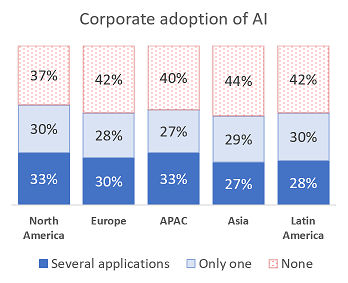 Familiarity continues to gobble up applications of artificial intelligence into the normal routine of stuff we take for granted: Speech recognition, automated translation, credit card and banking fraud detection and now, of course Alexa, Siri and their ilk that do a good deal more than just speech recognition. Forbes listed 10 Powerful Examples Of Artificial Intelligence In Use Today, and that was two years ago, which seems like an age.
Familiarity continues to gobble up applications of artificial intelligence into the normal routine of stuff we take for granted: Speech recognition, automated translation, credit card and banking fraud detection and now, of course Alexa, Siri and their ilk that do a good deal more than just speech recognition. Forbes listed 10 Powerful Examples Of Artificial Intelligence In Use Today, and that was two years ago, which seems like an age.
AI is definitely here today, and it’s the future, and times are changing. AI has become a badge for marketeers in a way that’s new – just search for “AI applications” and you can see there’s no shortage of people strutting their stuff with plenty of fanfare. Some are selling complexity and scale, some are offering to make it all very simple and the benefits swift. There’s a great deal going on all over the place.
For all this activity, current deployment rates say that we’ve hardly started. McKinsey’s recent research note is just one example: Global AI Survey: AI proves its worth, but few scale impact.
So where are the signposts that point to where this is heading? Is this it and the main areas of opportunity have started to close already?
Forks in the road ahead
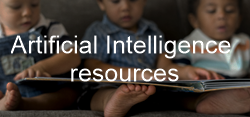 The indications are that we’re just entering mainstream adoption in Western enterprises with a large commercial opportunity for deployment ahead of us. However, there are several important trends in play that indicate how things will change.
The indications are that we’re just entering mainstream adoption in Western enterprises with a large commercial opportunity for deployment ahead of us. However, there are several important trends in play that indicate how things will change.
In several ways AI is bifurcating.
China vs the West: The competition between China and the West for AI supremacy is in the headlines now, but has been developing for some time. Government sponsorship in the USA and China has long been focused on artificial intelligence development and leadership. It’s amazing to realise that the DARPA Grand Challenge held its first race in 2004 for a prize of just $1m. It was fun to watch the progress each year, but it was a hard nosed Government initiative. It paid off, too.
| An art exhibition has opened in China reflecting on the loss of anonymity to recognition technology More…. |
These incentives, pressures and opportunities are producing dissimilar results, though. AI is all about mechanising what would otherwise be done by humans for reasons of cost, efficiency and scale, and China is not short of low cost labour and, consequently, Chinese AI is driven by the government appetite for surveillance, information gathering, and control. In contrast, the opportunity in the West leans more heavily towards cost reduction and efficiencies, and opening new opportunities for businesses and other organisations.
Data Haves and Have Nots: Data is the crucial fuel for AI systems, both in the initial training and for all deployment that seeks to understand the evolving world around. So the players in the AI sector – developers and those deploying – are beginning to separate into Data Haves and Data Have Nots. Regulation and public opinion are playing into this and compromising the way forward for all those who don’t have justifiable access to the data they need and the right to use it. The definitions around this are becoming tighter and more specifically drawn all the time. Everyone who’s not in this elite group must find a way around this constraint.
Enterprises vs SMEs: Size matters when it comes to artificial intelligence. The cost of training of an AI model to bring it to decent accuracy is the same for an SME as it is for a gigantic enterprise, often pricing it out of bounds for smaller organisations. Paradoxically, the internal processes and other hurdles in the way of adoption usually make this harder for a bigger organisation. Data can also be a factor, since larger organisations often have large volumes of the stuff readily to hand, compared to SMEs. So adoption dynamics and economics are very different, depending on size and scale.
 Develop vs Buy vs Rent: Huge data and compute loads are now required to train models to acceptable levels of accuracy, and this costs time and treasure. Simple models and passable accuracy can already be had fairly simply and at quite low cost, with pay-for-use AI available through an API and ready to go. At the other end of the spectrum, some firms are working on bespoke processing hardware to crunch the kind of loads and specialist work being encountered at the lading edge, and Cloud is starting to make this more accessible. So a wide range of possibilities confronts decision-makers, requiring strategic decisions and choices to be made that will be hard or costly to reverse.
Develop vs Buy vs Rent: Huge data and compute loads are now required to train models to acceptable levels of accuracy, and this costs time and treasure. Simple models and passable accuracy can already be had fairly simply and at quite low cost, with pay-for-use AI available through an API and ready to go. At the other end of the spectrum, some firms are working on bespoke processing hardware to crunch the kind of loads and specialist work being encountered at the lading edge, and Cloud is starting to make this more accessible. So a wide range of possibilities confronts decision-makers, requiring strategic decisions and choices to be made that will be hard or costly to reverse.
Maybe that’s just the easy stuff?
 There is a tidal effect of research and deployment, with R&D being followed by go-to-market, only to be followed itself by the next wave of R&D. Artificial intelligence techniques are heavily influenced by complexity and sophistication. Inevitably, the stuff that’s easiest to do gets developed first and deployed first. There are clear hurdles that make onward progress look a lot like climbing a staircase.
There is a tidal effect of research and deployment, with R&D being followed by go-to-market, only to be followed itself by the next wave of R&D. Artificial intelligence techniques are heavily influenced by complexity and sophistication. Inevitably, the stuff that’s easiest to do gets developed first and deployed first. There are clear hurdles that make onward progress look a lot like climbing a staircase.
Developing algorithms within a single domain is comparatively straightforward. Recognising birds, say, only gets complicated if you want to cater for the fact that they’re not all fist size things that fly and sing, and you don’t mind occasionally stumbling onto a black swan, for example. Volvo ran into the problem of outliers, almost literally, when the autonomous vehicle system they were training in Australia saw a jumping kangaroo, and rationalised it as an animal that was suddenly much further away and huge, returning to its previous size and proximity when it landed.
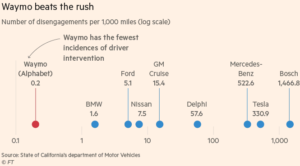 An algorithm to understand what happens when a pen rolls off a table requires knowledge of a greater range of possibilities if it might fall into a bucket of water. Context widens the dimensions of required data dramatically, but going beyond the obvious is essential if systems are to interpret inputs correctly, as a human would, The meaning of “I could murder a Chinese” depends on context: Friday evening in downtown St.Albans, say, versus Monday at 3am, near a border somewhere in Asia.
An algorithm to understand what happens when a pen rolls off a table requires knowledge of a greater range of possibilities if it might fall into a bucket of water. Context widens the dimensions of required data dramatically, but going beyond the obvious is essential if systems are to interpret inputs correctly, as a human would, The meaning of “I could murder a Chinese” depends on context: Friday evening in downtown St.Albans, say, versus Monday at 3am, near a border somewhere in Asia.
Big incentives towards tomorrow
Cross domain knowledge, reasoning in uncertainty, and other steps represent new levels of algorithmic complexity that are yet to be mastered and commoditised, with their substantially different requirements for data and compute. The research work on autonomous vehicle systems will have substantial payback elsewhere, as it must get to grips successfully with many of these substantial higher order challenges. Even in this field, though, the range of effort and success to date – good and bad – is astonishing.
Artificial intelligence development effort in medicine is very large, too, and this will be another source of valuable techniques and know how that will filter beyond its original domain. Medicine is benefitting from the golden coincidence of very large budgets, large populations of beneficiaries with political advantage, and huge pools of the right data.
| Smart Cities, Safe Cities |
The same kind of Golden coincidence occurs around cities, and has spurred major initiatives known as Smart Cities and Safe Cities. Most of the global technology companies have big divisions focused in these areas, and there are many live projects and programmes, globally.
Four kinds of challenge lie ahead for AI
Research: Academic, commercial and government pressures are focused on a competitive effort to extend the sophistication and capabilities of AI techniques, and prove these in early deployment. This is crucial to move us on from the simple and simplistic chatbots today, to techniques that allow fast learning that reduces the burden of training and enables systems to adjust as circumstances change in this fast moving environment. Intuition, cross-domain reasoning and common sense must become precise, straightforward and cost effective techniques before we can move confidently to the next level of value from artificial intelligence.
| Data protectionism: the growing menace to global business |
| Scania is well used to its vehicles being delayed at border crossings by officious customs officers and laborious paperwork. Yet these days, the Swedish truck company’s business is hindered as much by international obstructions to its data as roadblocks on its lorries. More…. |
Data: The essential fuel to drive training and deployment is data of the right structure, volume and quality. Many who have the raw material are yet to find ways of refining it adequately and extracting value, and those that don’t have it are exploring ever more creative ways of acquiring it from other people, or doing without it. Expertise and effort is needed to help those with data and those with legitimate interests in acquiring it. In many ways, the most difficult challenge is to raise data quality, because deficiencies like bias can often be hidden and undetected, until uncovered by testing or poor results.
Regulation: The action of Governments and Regulators is often like pressing on a water bed: press down here and some other effect pops up elsewhere. Regulation can be good and bad and, for artificial intelligence, it can be driven by narrow State interests, or a wider debate about ethics and social values.
The debate about ethics is important but is often about the possibilities in the distant future, and this taints the value we might all get from rather more ordinary uses, today. Difficult issues lie ahead as models get more sophisticated, potentially making it hard and even impossible to know how or why conclusions were reached by the systems. A Facebook project was shut down when it was discovered that two AI systems were talking together in their own language that no one else could understand.
Data protectionism and other controlling behaviour by national agencies throws more sand in the AI gearbox, with recent action in India, Russia, California and elsewhere, giving us the latest examples. This unstable, unpredictable landscape is the joker in the pack for those focused on practical, real world deployment of AI to bring the benefits into society.
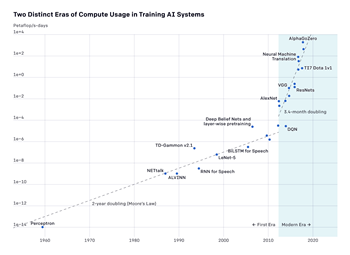 Compute: AI is a demanding, insatiable beast, and its appetite for compute power is driven by data volumes and modelling complexities. Neither of these is in decline. A sharp acceleration in the consumption of compute power by AI occurred around 2012 as models, training, data, and deployment got into their stride.
Compute: AI is a demanding, insatiable beast, and its appetite for compute power is driven by data volumes and modelling complexities. Neither of these is in decline. A sharp acceleration in the consumption of compute power by AI occurred around 2012 as models, training, data, and deployment got into their stride.
Stamford reports in its AI Index for 2019 that the availability of the right hardware and Cloud infrastructure resources has reduced training time by more than two orders of magnitude in less than two years. These techniques will need to be refined and made generally available if we are to press on up the staircase to realise practical, higher levels of performance, and Richard Waters of the FT has drawn some powerful conclusions about the way forward: Hardware revolution pushes AI into the mainstream
And meanwhile?
The good news is that AI is all over the place, and the bad news is that AI is also all over the place. All sorts of commercial opportunities are available in artificial intelligence today, if they are seen through the lens of insight into the trends and challenges.
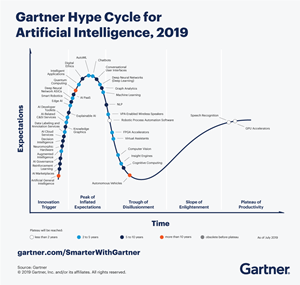 Practical opportunities are there for organisations and entrepreneurs, with quick wins available with what we’ve got today, but the limitations and vulnerabilities need to be understood and a weather eye devoted to watch out as the developments unfold. Solutions incorporating seductive, third party, AI-as-a-Service resources may have hidden issues and disadvantages. Research heavy projects may fail to light up the C Suite in major organisations. It will be easy to get boxed in by what turns out to be a blind alley that compromises enduring value.
Practical opportunities are there for organisations and entrepreneurs, with quick wins available with what we’ve got today, but the limitations and vulnerabilities need to be understood and a weather eye devoted to watch out as the developments unfold. Solutions incorporating seductive, third party, AI-as-a-Service resources may have hidden issues and disadvantages. Research heavy projects may fail to light up the C Suite in major organisations. It will be easy to get boxed in by what turns out to be a blind alley that compromises enduring value.
Agility and deft footwork will be needed to sidestep the barriers and navigate the hurdles to adoption that are so often driven by the realities of organisational culture that conspire against the efforts of reasoned aspiration. Insight matters.
Not surprisingly, the fastest, most willing adoption comes when applications directly align with real and present issues in the customer’s Line of Business. With lots to choose from, careful choices are needed against the backdrop of a rapidly evolving landscape.
Always watching the horizon
Astute decision makers, be they entrepreneurs, investors or those in organisations looking for the benefits of AI, all will need to watch the horizon for insights into developments in new techniques, ethics and other regulatory pressures, data, and viable infrastructure to realise practical, cost effective solutions.
| First Page | Previous Page | Next Page | Advisory |
 |
 |
 |
 |
Blogs on: Strategy, Trends, Management
Also: Artificial Intelligence Resources
Peter is chairman of Flexiion and has a number of other business interests. (c) 2019, Peter Osborn